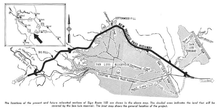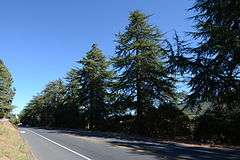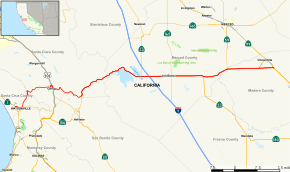California State Route 152
| ||||
|---|---|---|---|---|
|
Map of western California with SR 152 highlighted in red | ||||
| Route information | ||||
| Defined by Streets and Highways Code § 452 | ||||
| Maintained by Caltrans | ||||
| Length: |
104.419 mi[1] (168.046 km) (plus about 1.5 mi (2.5 km) on US 101) | |||
| History: | State highway in 1916; SR 152 in 1934 | |||
| Restrictions: | No tractor-trailer combinations over 45 feet (14 m) in length through Hecker Pass[2] | |||
| Major junctions | ||||
| West end: |
| |||
| East end: |
| |||
| Highway system | ||||
| ||||
State Route 152 (SR 152) is a state highway that runs near the latitudinal middle of the U.S. state of California from Watsonville to Route 99 southeast of Merced. Its western portion (which is also known as Pacheco Pass Road and Pacheco Pass Highway) provides the best access to and from Interstate 5 toward southern California for motorists in or near San Jose.
This route is part of the California Freeway and Expressway System[3] and is eligible for the State Scenic Highway System.[4]
Route description
Route 152 begins near Route 1 as a series of local streets that run through downtown Watsonville: East Lake Avenue carries it to the intersection of Casserly Road. This point marks the start of a winding two-lane highway that crosses the Santa Cruz Mountains through Hecker Pass to reach Gilroy. In Gilroy, it is again carried on a series of local streets, then overlapped onto U.S. Route 101 for a small stretch before it separates again a short distance to the south and returns to heading east/west on more local streets in Gilroy.
After exiting the large commercial developments near U.S. 101, Route 152 consists of a single lane in each direction, with narrow shoulders, rain ditches on either side of the road, no center dividers, and posted speed limit of 55 mph (89 km/h), making it prone to head-on collisions. Headlights are required at all times along this portion. This segment is a significant bottleneck for traffic traveling along Route 152 between the San Francisco Bay area and the Central Valley. Upon reaching Route 156 near Hollister, the road expands to two lanes in each direction, and climbs and curves along the valley of Pacheco Creek into the mountains of the Diablo Range, crossing them through the Pacheco Pass into the San Joaquin Valley.
Route 152 continues as a four-lane divided expressway, descending along the northern and eastern shore of the massive San Luis Reservoir. The route passes in between the San Luis Dam and the O'Neill Forebay. The route continues east and passes a large Path 15 substation and then meets Interstate 5 as an expressway. It becomes a speed-limited city street, Pacheco Blvd., while passing through Los Banos. It then returns to an expressway until its eastern terminus at Route 99. Here, eastbound 152 traffic merges on to southbound 99 a few miles northwest of the city of Madera, and approximately 25 miles (40 km) northwest of Fresno. Motorists wishing to travel north on Route 99 are advised to take Route 233 north through Chowchilla to connect to northbound 99. Another possible northbound route exists by exiting Route 152 at State Route 59, and proceeding directly north to the city of Merced, where Route 59 meets Route 99.
The landmarks located on Route 152 include the Pacheco Pass, the Gilroy Gardens, the San Luis Reservoir, the Casa de Fruta and the Merry Cherries.
History


|
Highway 152 Tree Row | |
 | |
| Nearest city | Gilroy, California |
|---|---|
| Built | 1930-1931 |
| NRHP Reference # | 07000635[7] |
| Added to NRHP | July 3, 2007 |
The road became popular as a route east during the California Gold Rush. The Butterfield Overland Mail ran along this route from 1858 to 1861. A portion of Route 152 from Bell Station to Pacheco Pass was a toll road from 1857 until 1878. In that year, Merced County and Santa Clara County purchased the toll road and replaced it with a new road built as a public highway, part of which is now a segment of Whiskey Flat Trail in Pacheco State Park. In 1915, the road became part of the state highway system, and in 1923, the state built the third road through the pass. Historic references say the portion of the route west of SR33 was named Legislative Route 32 before being designated State Route 152.[8][9][10]
The 1923 state route between Bell Station and Pacheco Pass had numerous curves and steep grades. In 1939, a realignment of 2.6 miles of highway was completed eastward from the Pacheco Reservoir area (starting about a mile east of Bell Station). In 1950, the first four-lane expressway segment was constructed from the 1939 alignment to near the Merced County line, a distance of 3.26 miles.[5][10][11] The 1939 and 1950 alignments continue to be in use today.
In 1963-65, a new 12-mile four-lane expressway, with climbing lanes for trucks, was built from the Merced County line eastward, to bypass the San Luis Reservoir which was then under construction.[6][12] A three-mile stretch of the bypassed road continues to be in use as Dinosaur Point Road, providing access to a boat launch ramp at the reservoir.
Between 1982 and 1992, the road was widened in three stages from two to four lanes, with some realignments, on a 10.5-mile segment from the four-lane section completed in 1950 to just east of the junction with California State Route 156, with an interchange built at Casa de Fruta. In 2008, a T-junction and stop sign at the intersection with Route 156 on the remaining two-lane section of the highway west of Casa de Fruta was replaced with a flyover, greatly easing congestion there.[13]
A segment of Route 152 west of Gilroy, between the Uvas Creek Bridge and Santa Teresa Blvd, was added to the National Register of Historic Places in 2007.[7] This segment of the road, serving as a western gateway into Gilroy, is lined with deodar cedar trees that were planted on consecutive Arbor Days in 1930 and 1931.
Major intersections
Except where prefixed with a letter, postmiles were measured on the road as it was in 1964, based on the alignment that existed at the time, and do not necessarily reflect current mileage. R reflects a realignment in the route since then, M indicates a second realignment, L refers an overlap due to a correction or change, and T indicates postmiles classified as temporary (for a full list of prefixes, see the list of postmile definitions).[1] Segments that remain unconstructed or have been relinquished to local control may be omitted. The numbers reset at county lines; the start and end postmiles in each county are given in the county column.
| County | Location | Postmile [1][14][15] | Destinations | Notes | |
|---|---|---|---|---|---|
| Santa Cruz SCR T0.31-8.29 | Watsonville | T0.31 | Interchange; westbound exit and eastbound entrance; west end of SR 152 | ||
| T2.50 | Freedom Boulevard – Freedom | ||||
| T3.27 0.00 | Lincoln Street | ||||
| | R1.99 | Holohan Road, College Road – Freedom, Santa Cruz | |||
| | 3.69 | Carlton Road, Casserly Road | |||
| Santa Clara SCL 0.00-R35.16 | | 5.03 | |||
| Gilroy | 7.93 | Santa Teresa Boulevard | Serves Gavilan College | ||
| M9.43 | West end of US 101 Bus. overlap | ||||
| M9.78 | East end of US 101 Bus. overlap | ||||
| M10.28 R7.53[N 1] | Interchange; west end of US 101 overlap | ||||
| West end of freeway on US 101 | |||||
| East end of freeway on US 101 | |||||
| R6.08[N 1] R9.91 | Interchange; east end of US 101 overlap | ||||
| | 12.81 | ||||
| | 14.89 | ||||
| | R21.98 | Interchange; no westbound entrance | |||
| | R23.41 | Casa de Fruta Parkway | Interchange | ||
| Merced MER R0.00-R40.95 | | 11.27 | Interchange; west end of SR 33 overlap | ||
| | 13.85 | Interchange | |||
| Los Banos | 21.27 | ||||
| | R32.37 | Interchange; east end of SR 33 overlap | |||
| Merced–Madera county line | | R40.77– R0.06 | Interchange | ||
| Madera MAD R0.00-15.63 | | 10.80 | Interchange | ||
| Califa | 15.63 | Interchange; eastbound exit and westbound entrance; east end of SR 152; former US 99 | |||
1.000 mi = 1.609 km; 1.000 km = 0.621 mi
| |||||
References
- 1 2 3 California Department of Transportation. "State Truck Route List". Sacramento: California Department of Transportation. Archived from the original (XLS file) on June 30, 2015. Retrieved June 30, 2015.
- ↑ "Special Route Restriction History - Route 152". Caltrans. Retrieved 2014-07-25.
- ↑ CA Codes (shc:250-257)
- ↑ CA Codes (shc:260-284)
- 1 2 Payson, H. (September 1939). "Pacheco Pass Realignment Job Completed Abolishing 31 Curves" (PDF). California Highways and Public Works. Sacramento, California, United States: Department of Public Works, State of California. 17 (9): 6–7. Retrieved April 26, 2014.
- 1 2 Kroeck, Louis (March–April 1963). "Pacheco Pass, Highway Relocation Includes 11,400,000-cubic-yard Fill" (PDF). California Highways and Public Works. Sacramento, California, United States: Department of Public Works, State of California. 42 (3-4): 45–49. Retrieved April 26, 2014.
- 1 2 National Park Service (March 13, 2009). "National Register Information System". National Register of Historic Places. National Park Service. Retrieved July 26, 2012.
- ↑ Myer, Chuck, report: Pacheco Past: A History of the Gateway to Santa Clara County, (San Jose, California: Pioneers of Santa Clara County, 1992), page 9.
- ↑ Shumate, Dr. Albert, Francisco Pacheco of Pacheco Pass, (Stockton, California: University of the Pacific, 1977). This information is repeated in other sources.
- 1 2 Levier, G. (March–April 1951). "Pacheco Pass, Portions of Historic Road Realigned To Meet Important Industrial Needs" (PDF). California Highways and Public Works. Sacramento, California, United States: Department of Public Works, State of California. 30 (3,4): 34–37. Retrieved April 26, 2014.
- ↑ Skeggs, Jno. (February 1939). "Pacheco Pass Realignment Deletes 31 Curves, Steep Grades" (PDF). California Highways and Public Works. Sacramento, California, United States: Department of Public Works, State of California. 17 (2): 10–12. Retrieved April 26, 2014.
- ↑ Weavern, R. (July–August 1965). "Pacheco Pass, Route 152 Now Skirts San Luis Reservoir Site" (PDF). California Highways and Public Works. Sacramento, California, United States: Department of Public Works, State of California. 44 (7-8): 2–7. Retrieved April 26, 2014.
- ↑ Richards, Gary (November 10, 2007), "Pacheco Pass unplugged: Relief on the way at 152-156 interchange", San Jose Mercury-News.
- ↑ California Department of Transportation, Log of Bridges on State Highways, July 2007
- ↑ California Department of Transportation, All Traffic Volumes on CSHS Archived July 21, 2011, at the Wayback Machine., 2006
External links
| Wikimedia Commons has media related to California State Route 152. |

